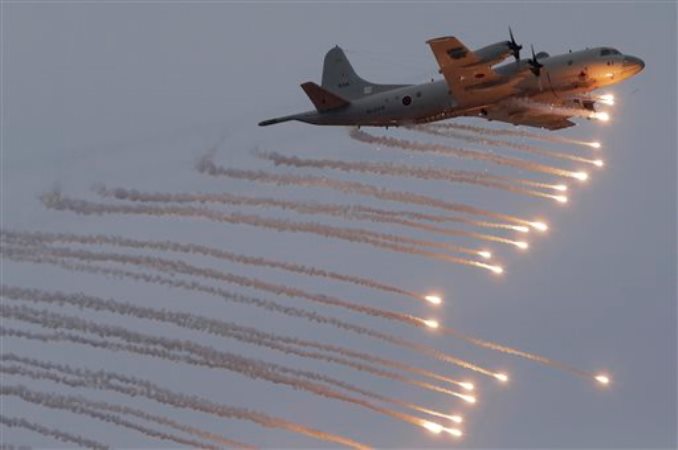
A tiny military exercise in the Philippines this week may presage something much bigger: the entry of Japan into the tussle for control of the South China Sea.
A Japanese surveillance plane and about 20 troops conducted the first of two days of joint training with the Philippine navy on Tuesday off the coast of Palawan, a strategically important island not far from contested islands claimed by several countries including China and the Philippines.
While the P-3C plane was being used for maritime search-and-rescue drills and disaster relief drills, the aircraft is also a mainstay of Japan's anti-submarine and other aerial surveillance efforts. In theory, it could help the U.S. keep an eye on the Chinese navy in the South China Sea.
Some experts think that's a possibility in coming years.
"It's likely we will see Japan doing joint surveillance and reconnaissance in the South China Sea in the coming years," said Narushige Michishita, a defense expert at the National Graduate Institute for Policy Studies in Tokyo. "It is going to be with the U.S., Australia, the Philippines and others."
Others are less certain. Such a move would raise tensions with China, with which Japan already has a major territorial dispute over islands farther north in the East China Sea. It would face public opposition at home from those who want Japan's military to avoid getting entangled in overseas disputes. The military is already stretched, keeping an eye for example on North Korea and China in the East China Sea.
Takashi Manzen, speaking for the Japanese delegation, said the P-3C, which was manned by 13 Japanese flight crewmembers and accompanied by three Filipino military personnel, flew 100 kilometers (62 miles) westward from Palawan island with a Philippine navy islander toward the South China Sea in a mock search for a missing ship.
While the Philippines and Japan can possibly hold similar drills in the future, Manzen told The Associated Press that these would remain focused on improving disaster response, "not patrolling, not surveillance."
Chinese Foreign Ministry spokesman Lu Kang expressed concern about the exercise.
"We hope that the sides in question do not play up and create tensions on purpose, and that any interactions between those countries would actually contribute to regional peace and stability, rather than the opposite," Lu told reporters at a regular briefing.
Philippine naval personnel flew on board the Japanese P-3C to observe operations and learn techniques and procedures, Col. Jonas Lumawag of the Philippine navy told reporters. The P-3C communicated with a smaller Philippine plane on a hypothetical search mission for a missing ship or plane.
Both Japanese and Philippine commanders stressed that the drill was to practice search-and-rescue, and said they weren't aware of any plans for joint patrols.
The exercise follows the first-ever joint drill between the two navies six weeks ago, and is part of a confluence of developments that suggest Japan may at least test the waters in the South China Sea. Consider this:
— Japan's parliament is debating legislation this summer that would loosen post-World War II restrictions on its military to allow it operate outside of the immediate area. Under questioning by opposition lawmakers, Defense Minister Gen Nakatani said that could include patrols in the South China Sea in certain situations — though he added Japan has no current plans for that.
— The new head of the U.S. Pacific Command, Adm. Harry Harris, told the Japanese media on a recent visit to Tokyo that the P-3 aircraft, which the U.S. also uses, is well suited to patrol the South China Sea. He added that he welcomes Japan's willingness to play a larger role in regional security. The U.S. is looking for help from Japan, Australia and other allies as it confronts Chinese challenges to its naval dominance in the Pacific.
— The drill coincides with rising American criticism of China for reclaiming land and building structures on disputed islands and outcroppings in the South China Sea. Japanese officials are also openly critical of China's attempts to establish its territorial claims through construction.
"Certainly the current Japanese government seems to be seriously signaling that this is a possibility," said Corey Wallace, a security analyst joining the Freie Universitat in Berlin in July.
"My sense is that the Japanese government is putting into place the necessary legal and military mechanisms as preparation ahead of making a final decision about whether to get more directly involved later down the track."
